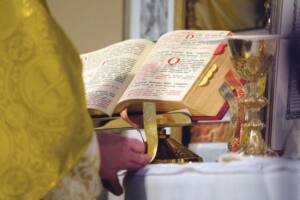Like charity, Christian unity begins at home
Published on 5th Sep, 2022
WelCom September 2022

This article, in three parts, by Bishop Peter Cullinane coincides with Pope Francis’ desire for our parish liturgies to be as they as they should be, and for the Catholic people to receive on-going liturgy formation. Pope Francis’ most recent Apostolic letter, Desiderio Desideravi – ‘I have desired with a great desire’ (Lk 22:15), published on June 29, 2022, deals with this. It is a follow-up to his letter, Traditiones Custodes – ‘Guardians of the Tradition’, issued nearly one year earlier on July 16, 2021, in which he called for the Traditional Latin Mass to be terminated.
- Wasn’t the Traditional Latin Mass the ‘Mass of the ages’?
Yes, which is why it adapts to the different ages. We have only to read St Justin’s beautiful description of the Mass dating from c. 155 AD to realise that the form of the Mass does change. The Mass St Justin knew would eventually live on in the revised Missal Pope Pius V promulgated after the Council of Trent; (the ‘Traditional Latin Mass’). And that Mass now lives on in the revised Missal promulgated by Pope Paul VI after the Second Vatican Council. Both Missals have resulted from revisions of previous texts. That is the sense in which we can speak of ‘the Mass of the ages’. And that is the sense in which Tradition lives on even as small traditions come and go.
- Was the 1962 Missal ‘abrogated’?
No, but that only means it was not annulled, and so it can still be validly used when the Pope authorises it to meet special needs. It was withdrawn from normal use. Pope Paul VI made it clear that the revised form of the Missal replaced the unrevised form.
- Why did the Second Vatican Council require the Missal to be revised?
Historical research contributed to the reform which gave us the ‘Traditional Latin Mass’. Likewise, the Second Vatican Council’s reform had at its disposal up-dated scholarship based on ancient Christian sources even more recently discovered. According to Pope Paul VI, the Council intended
(i) to make it easier for people to see the meaning of the various parts of the Mass and the connection between them, and easier for people to participate;
(ii) open up the scriptures more abundantly; and
(iii) restore elements of the Mass which, through the accidents of history, had become obscured. (For example: reflecting the influence of Jansenism, the unrevised Missal still instructs the priest what to do if anyone wants to receive Holy Communion; whereas reflecting the later influence of Pope St Pius X, the revised Missal expects that most of the congregation will be receiving Holy Communion.)
The Council taught that ‘full, conscious and active participation in the liturgical celebrations is required by the very nature of the liturgy’ (Liturgy 14).
- Who celebrates the Mass?
Our previous formation left many of us with the impression that the priest celebrated the Mass and the rest of us ‘attended’ Mass. People adjusted to this understanding, so that while the priest prayed the prayers of the Mass, they often filled in the time with their own prayers. The reality, however, is that Mass is celebrated by the whole congregation (cf Catechism of the Catholic Church, 1140). That is why it requires their ‘full, conscious and active participation’, whether by word, song, gesture, or stillness and deep silence – but acting as ‘one body, one spirit in Christ’. The way we participate is not determined by ‘personal preference’, (which is what contemporary secular culture emphasises).
The priest’s role is still special: he does not act on Christ’s behalf because it is Christ himself who acts – through the priest who has been ordained to act in his Person. But this does not make him the only ‘celebrant’. According to the prayers of the Mass itself, ‘offerimus’, that is, ‘we offer’.
- Reverence:
Reverence is body language par excellence. It is the demeanour that comes naturally when we are aware of being in God’s presence. But there are different ways of being in God’s presence, and different expressions of reverence. For example, the reverence proper at a graveside; the reverence proper to adoration of the Blessed Sacrament, etc. Each is important in its own circumstances.
The kind of reverence proper to liturgy corresponds to the ways Christ is really present. According to the Council (Liturgy, 7), Christ is present:
– in the congregation (‘where two or three are gathered…’);
– in the word (where ‘Christ is speaking to his people’ – present tense);
– in the ministry of those ordained to act in the name of Christ;
– and especially in the Sacrament.
These four different manifestations of Christ’s real presence invite different ways of responding. The appropriate way of responding to each is the appropriate way of being reverent.
And so, for example: how we respond to Christ present in his word is different from how we respond to his presence in the Sacrament, and how we acknowledge His presence in the gathering. Greeting one another before Mass begins, followed by a period of silence, helps to form the community that is about to worship as one body. The way we relate to people who have ‘gathered in his name’ is different from the ways we relate to people who have gathered for social occasions.
To require only one way of being reverent (for example, the reverence due to the Blessed Sacrament), excluding the others, is against the nature of the liturgy.
- Posture
In the liturgy, postures and gestures are statements of faith. They are ways of saying – with our whole self – what we believe and what we are doing. They em-body and en-act our inner dispositions, and deepen them. That is why we don’t just ‘do’ them; we need to really mean them – make them mean what our minds and hearts want to say. They also enable the congregation to act as one body.
For example, the presence of Christ is beautifully acknowledged when the book of the Gospels, symbolising Christ, is brought into the assembly, accompanied by song – and in some cultures, dance – and the congregation rises to its feet.
The custom of kneeling during the Eucharistic Prayer is regarded as ‘laudable’. But it is important to understand the early Christians’ practice of standing. Eucharistic Prayer I, originating around the year 375, refers to the congregation ‘standing around’ (‘circum-stantes’ – currently translated as ‘gathered here’). The even older Eucharistic Prayer II, originating around the year 215, refers to our being counted ‘worthy to stand in Your presence’ (currently mistranslated as ‘being in Your presence’).
At Benediction, we are adoring Christ, for which the appropriate body language is ‘down in adoration falling…’. That is not mainly what we are doing during the Eucharistic Prayer. The Eucharistic Prayer is addressed almost entirely to the Father. The appropriate body language is that which best corresponds with what the Eucharistic Prayer is saying. For those early Christians, standing was body language for acknowledging that in Christ we have been raised up.
That is why St John Chrysostom forbade his people to kneel during the Easter season; so did St Augustine. The Council of Nicea forbade kneeling for prayer on Sundays; and when in the ninth century kneeling became more common, it was only on non-festive days, never on days that commemorate the resurrection of Jesus, that is, Sundays and feast days. Standing is still the posture in the Eastern Churches.
Part 3 will conclude Bishop Cullinane’s article in the October edition of WelCom.
The post Like charity, Christian unity begins at home first appeared on Archdiocese of Wellington.
Bishops Issue Letter on Occasion of Royal Commission Apology
Bishop
Published on 20th Nov, 2024
Earlier this week, we bishops gathered together and listened as the Prime Minister apologised to [..]
Truly listening to others
Bishop
Published on 5th Oct, 2024
I write this editorial comment to you from Rome [in September] where, along with Bishop Richard [..]
NZ’s ‘baby bishops’ attend bishops’ school in Rome
Bishop
Published on 5th Oct, 2024
Two New Zealand bishops, Richard Laurenson and John Adams, attended the Baby Bishops course in Rome [..]
Remembering St John Paul II’s inspiring evangelisation
Bishop
Published on 13th Aug, 2024
Pope Francis is often quoted as having said, as a Catholic community, we are less living in an era [..]
Remembering St John Paul II’s inspiring evangelisation
Bishop
Published on 3rd Aug, 2024
Pope Francis is often quoted as having said, as a Catholic community, we are less living in an era [..]
